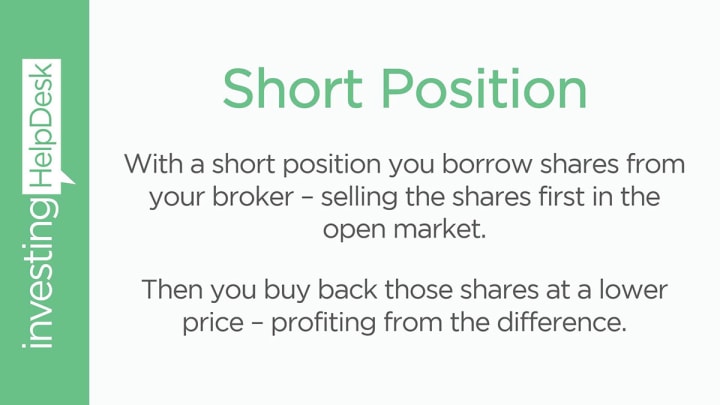Defining ‘The Big Short’
In Blingo, Business Lingo, what is a “big short”, how does it apply to trade, and how can you benefit from it?
There are two sides an investor can take in a trade: a long position or a short position. For the average investor investing in their retirement accounts, a long position is all they need to worry about.
However, for investors looking for additional profit potential, then using short positions can be a viable option. Let’s examine what both long and short positions are, and then discuss the pros and cons of using shorts in your own portfolio.
What are Short Positions and Long Positions?

Similar to drawing the "long" and "short" stick.
As a do-it-yourself investor, it is important to understand the various tools that are available for you to grow your investment account. Although investing does not need to be overly complex, it is important that you fully understand the strategies you are using before you put them into practice.
This is especially important when considering using short positions in your accounts.
Let’s have a look at what both long and short positions are so you can understand the fundamental differences between the two. We will start with what a long position is.
Long Position Defined

Long Position = You Want the Share Price to Go Up
When you take on a long position, or go long on a stock, it means you are buying stock in a company expecting the share price to rise (go up) over time.
In other words, you buy 100 shares of Apple stock today for $98.23 and hope to sell it sometime in the future for a price that is higher than $98.23.
Short Positions Defined

Image via Investing Help Desk
Short Position = You Want the Share Price to Go Down
A short position is the opposite of a long position. Remember that when you buy a long position in a stock, you are expecting the share price to go up.
When you take on a short position, you are expecting the share price to go down. In other words, you are expecting that the stock and/or the company will not perform well (sorry, Apple!). A short position allows you to profit from the decline in a stock’s price.
To fully understand how a short position works, it is easier to look at a specific example. Using Apple stock again, let’s see how a short position works:
- To go “short a stock,” you need to borrow the stock from your broker. Let’s say we want to short 100 shares of Apple – you would borrow the 100 shares of Apple stock from your broker.
- You would then turn around and sell those 100 borrowed shares in the market. In return for selling those shares, you receive the proceeds from selling the shares into your account. In this case you sold your 100 shares for $105.52 per share which gives you a +$10,552 credit.
- Remember that you borrowed those shares from your broker, so technically this $10,552 is not yours to keep forever. You will eventually need to pay the broker back, plus interest charges. In the investment business, this is typically referred to as margin.
- Now that you sold those shares, this is where things get interesting. Your profit or loss depends on what happens to the price of Apple stock over the next few days. Let’s look at the two scenarios that can happen:
Scenario 1: Apple share price goes down: This is what you hoped would happen. If Apple shares go down, you make money. In this example, Apple shares dropped huge and you bought back the Apple shares you sold for $92.34. That gave you a gain of $1,318:
- Borrowed and Sold Short 100 shares at $105.52: +$10,552
- Bought Back and Returned 100 shares at $92.34: - $9,234
- Profit: +$1,318
Scenario 2: Apple share price goes up: This is bad news for a short seller. Since you shorted Apple you wanted the price to go down, not up. In this example, Apple shares rallied and you had to buy back the shares you sold for $126.34. This gave you a loss of -$2,082:
- Borrowed and Sold Short 100 shares at $105.52: +$10,552
- Bought Back and Returned 100 shares at $126.34: - $12,634
- Loss: -$2,082
As you can see, a short position is not as straightforward or easy as a long position. However, once you understand the concept of having to borrow stock from your broker, selling that in the market, and then buying it back for a profit (share price drops) or loss (share price rises), then it become easier to understand over time.
A great example of a short position and the huge profit it can produce is highlighted in the movie The Big Short. In the movie, Michael Burry (played by Christian Bale) makes a bet that the housing market is going to crash and crash hard. To make that bet, he goes short the housing market through a specialized security.
One of two things were going to happen: either the security he bought was going to rise in value and he was going to lose a lot of money, or the housing market was going to crash as he was predicting and he would make a huge amount of money.
I think we all know what happened: the housing market indeed crashed and Michael Burry’s short position ended up providing his investors and him an approximately $800 million profit.
Shorting stocks can be incredibly profitable. However, they must be used properly. Let’s now have a look at the pros and cons of using short positions in your portfolio.
Pros of Using Short Positions in Your Portfolio

There are a few key reasons that going short, or taking a short position, in your portfolio can benefit you. Here are a few of the key pros:
- Allows you to make money if stock prices fall. As opposed to just going long and hoping the share price will rise, you can also make money if you think a company’s stock is going to do down.
- You don’t need a lot of money up front to go short. Since you are borrowing the stock and then selling it right away, the cash required is low.
- Allows you to hedge a long position that is losing money; going short on the same stock allows you to make up up for the money you lost by going long.
Cons of Using Short Positions in Your Portfolio

There are also a number of cons of using a short position in your portfolio. Many of these are the reasons a lot of investors stay away from shorting stocks. Here are the key cons of short selling:
- Your risk of loss is potentially limitless. For a stock you short, the share price can actually go up forever, meaning that you can lose a lot more money than going long.
- The brokerage account you use for short positions typically requires a margin account. This means that it is more complicated to use in tax-protected accounts like IRAs.
- When you borrow the stock to short, the brokerage firm will charge you interest while you are borrowing the stock. Depending on how high this interest charge is, your profits can be quickly reduced because of these fees.
- When you go long a stock, you have the benefit of being able to wait a long time for a stock to rise in value. Using short positions usually involves a much shorter timeframe due to the costs and unlimited risks. It is much more difficult to predict which way a stock is going to do on short-term timeframes.
An investor can either go long or short a stock. If you go long, then you expect the share price to go up over time.
If you go short, then you are making a judgement call that the share price will go down over time. It was a short position that Michael Burry took against the housing market in the movie “The Big Short”. That trade alone made he and his investors over $800 million.
Taking on a short position on a stock is more complicated that going long, however if you understand the mechanics of it, and the associated risks, it can open a whole other way for you to make money.
About the Creator
Natasha Sydor
brand strategy @ prime video
Enjoyed the story? Support the Creator.
Subscribe for free to receive all their stories in your feed. You could also pledge your support or give them a one-off tip, letting them know you appreciate their work.






Comments
There are no comments for this story
Be the first to respond and start the conversation.